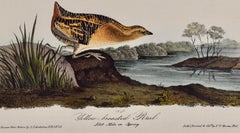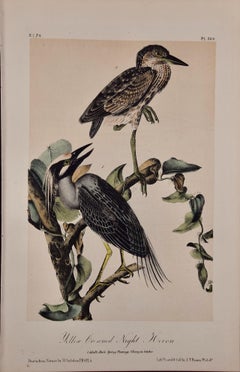Vellum Landscape Prints
to
1
Overall Width
to
Overall Height
to
1
1
1
1
1
1
1
1
1
1
1
1
3
1
1
1
1
Artist: Yves Brayer
Medium: Vellum
Before the Trotting Race - Original Lithograph Handsigned Numbered
By Yves Brayer
Located in Paris, IDF
Yves Brayer (1907-1990)
Before the Trotting Race
Original lithograph, c.1973
Handsigned in pencil by the artist
Numbered /250 copies
Size 50 x 65 cm, on Arches Vellum
Information: ...
Category
1970s Vellum Landscape Prints
Materials
Vellum, Lithograph
Related Items
Yellow-breasted Rail Bird: Original 19th C. Audubon Hand-colored Lithograph
Located in Alamo, CA
This is an original 1st octavo edition John James Audubon hand-colored lithograph entitled "yellow-breasted Rail, Adult Male in Spring", No. 62, Plate 307, from Audubon's "Birds of America". It was lithographed, printed and colored by J. T. Bowen and published in Philadelphia between 1840 and 1841. It depicts an adult male yellow-breasted Rail bird on the left standing on a rock on the bank of a body of water, looking to the right, perhaps at something in the water or on an island on the right with trees. The landscape surrounding the bird is striking.
This original 1st octavo edition hand-colored Audubon lithograph...
Category
Late 19th Century Naturalistic Vellum Landscape Prints
Materials
Lithograph
$220 Sale Price
20% Off
H 6.5 in W 10 in
Night Heron Birds: An Original 19th C. Audubon Hand-colored Bird Lithograph
Located in Alamo, CA
This is an original John James Audubon hand-colored lithograph entitled "Yellow Crowned Night Heron, 1. Adult Male Spring Plumage, 2. Young in October", No. 73, Plate 364 from Audubo...
Category
Late 19th Century Naturalistic Vellum Landscape Prints
Materials
Lithograph
$860 Sale Price
20% Off
H 10.25 in W 6.75 in
Haystack
Located in London, GB
A fine impression of this very popular image with full margins (smaller on top and bottom) published by Associated American Artists.
Category
1930s American Modern Vellum Landscape Prints
Materials
Lithograph
Nebraska Evening
Located in London, GB
A fine impression with good margins published by Associated American Artists.
Category
1940s American Modern Vellum Landscape Prints
Materials
Lithograph
Reddish Egrets, Adult & Young: An Original Audubon Hand-colored Bird Lithograph
Located in Alamo, CA
This is an original John James Audubon hand-colored lithograph entitled "Reddish Egret, 1. Adult, Full Spring Plumage 2. Young in Full Spring Plumage Two Years Old", No. 75, Plate 371 from Audubon's "Birds of America, lithographed, printed and colored by J. T. Bowen and published in Philadelphia between 1870-1871. It depicts an adult reddish egret standing in the water with leg up, looking to the left at a young white egret standing on land looking to the right at the adult bird. A beautiful landscape is depicted.
This original hand-colored Audubon egret...
Category
Mid-19th Century Naturalistic Vellum Landscape Prints
Materials
Lithograph
$1,420 Sale Price
20% Off
H 6.75 in W 10.25 in
Golden Eagle: An Original 19th C. Audubon Hand-colored Bird Lithograph
Located in Alamo, CA
This is an original John James Audubon hand-colored lithograph entitled "Golden Eagle", No. 3, Plate 12 from Audubon's "Birds of America, lithographed, printed and colored by JT Bowe...
Category
Late 19th Century Naturalistic Vellum Landscape Prints
Materials
Lithograph
$780 Sale Price
20% Off
H 10.25 in W 6.75 in
Canvass Back Duck: An Original 19th C. Audubon Hand-colored Bird Lithograph
Located in Alamo, CA
This is an original John James Audubon hand-colored lithograph entitled "Canvass Back Duck, 1. Male 2. Female, View of Baltimore, Maryland", No. 79, Plate 395 from Audubon's "Birds o...
Category
Late 19th Century Naturalistic Vellum Landscape Prints
Materials
Lithograph
$1,340 Sale Price
20% Off
H 6.75 in W 10.25 in
The Last War-Whoop!
Located in Palm Desert, CA
"The Last War-Whoop!" is a lithograph by Currier & Ives. The framed size is 26 x 32.62 x 1.25 inches.
Provenance:
Private Collection
Category
Late 19th Century American Realist Vellum Landscape Prints
Materials
Lithograph
Red-cockaded Woodpecker: A First Octavo Edition Audubon Hand-colored Lithograph
Located in Alamo, CA
This is an original John James Audubon hand-colored royal first octavo edition lithograph entitled "Red-cockaded Woodpecker, 1. 2. Male, 3. Female", No. 5...
Category
Mid-19th Century Naturalistic Vellum Landscape Prints
Materials
Lithograph
$460 Sale Price
20% Off
H 10.88 in W 6.75 in
"Washington Sea Eagle": An Original Audubon Hand-colored Lithograph
Located in Alamo, CA
This is an original John James Audubon hand-colored royal octavo lithograph entitled "Washington Sea Eagle", No. 3, Plate 13, from Audubon's "Birds of America". It was lithographed, printed and colored by J. T. Bowen and published in Philadelphia between 1856-1871. It depicts an adult male sea eagle perched on a rock.
This is an excerpt from Audubon's own description of this magnificent eagle, which includes how he came up with the name "Washington Sea Eagle":
"The name which I have chosen for this new species of Eagle, “The Bird of Washington,” may, by some, be considered as preposterous and unfit; but as it is indisputably the noblest bird of its genus that has yet been discovered in the United States, I trust I shall be allowed to honour it with the name of one yet nobler, who was the saviour of his country, and whose name will ever be dear, to it. To those who may be curious to know my reasons, I can only say, that, as the new world gave me birth and liberty, the great man who ensured its independence is next to my heart. He had a nobility of mind, and a generosity of soul, such as are seldom possessed. He was brave, so is the Eagle; like it, too, he was the terror of his foes; and his fame, extending from pole to pole, resembles the majestic soarings of the mightiest of the feathered tribe...
Category
Mid-19th Century Naturalistic Vellum Landscape Prints
Materials
Lithograph
$780 Sale Price
20% Off
H 10.5 in W 6.75 in
"Wildflowers & Butterflies" Color Lithograph Botanical Monarch Thistle Grass
Located in Austin, TX
Page size: 17.5 x 17 in.
Vintage Frame with gold leaf finish size: 24 x 26 in.
This intricately detailed lithograph depicts an vibrant floral scene against a warm, earthy backgroun...
Category
Mid-20th Century Vellum Landscape Prints
Materials
Paper, Lithograph
Red-shafted Woodpecker: A First Octavo Edition Audubon Hand-colored Lithograph
Located in Alamo, CA
This is an original John James Audubon hand-colored royal first octavo edition lithograph entitled "Red-shafted Woodpecker, 1. Male, 2. Female", No. 55, P...
Category
Mid-19th Century Naturalistic Vellum Landscape Prints
Materials
Lithograph
Previously Available Items
Horseback Riding in the Forest - Original Lithograph Handsigned Numbered
By Yves Brayer
Located in Paris, IDF
Yves Brayer (1907-1990)
Horseback Riding in the Forest
Original lithograph, c.1973
Handsigned in pencil by the artist
Numbered /250 copies
Size 50 x ...
Category
1970s Vellum Landscape Prints
Materials
Vellum, Lithograph
Vellum landscape prints for sale on 1stDibs.
Find a wide variety of authentic Vellum landscape prints available on 1stDibs. While artists have worked in this medium across a range of time periods, art made with this material during the 20th Century is especially popular. There are many well-known artists whose body of work includes ceramic sculptures. Popular artists on 1stDibs associated with pieces like this include Yves Brayer, Maurice Brianchon, Richard Florsheim, and Paul Guiramand. Frequently made by artists working in the Modern, all of these pieces for sale are unique and many will draw the attention of guests in your home. Not every interior allows for large Vellum landscape prints, so small editions measuring 0.01 inches across are also available

